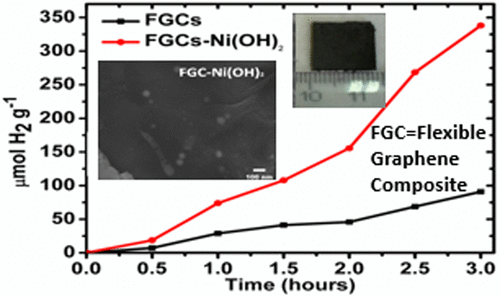当前位置:
X-MOL 学术
›
J. Phys. Chem. C
›
论文详情
Our official English website, www.x-mol.net, welcomes your feedback! (Note: you will need to create a separate account there.)
Photocatalytic Hydrogen Evolution by Flexible Graphene Composites Decorated with Ni(OH)2 Nanoparticles
The Journal of Physical Chemistry C ( IF 3.7 ) Pub Date : 2018-01-17 00:00:00 , DOI: 10.1021/acs.jpcc.7b10375 J. Oliva 1 , C. Gomez-solis 2 , L. A. Diaz-Torres 2 , A. Martinez-Luevanos 1 , A. I. Martinez 3 , E. Coutino-Gonzalez 4
The Journal of Physical Chemistry C ( IF 3.7 ) Pub Date : 2018-01-17 00:00:00 , DOI: 10.1021/acs.jpcc.7b10375 J. Oliva 1 , C. Gomez-solis 2 , L. A. Diaz-Torres 2 , A. Martinez-Luevanos 1 , A. I. Martinez 3 , E. Coutino-Gonzalez 4
Affiliation

|
This work presents the hydrogen evolution produced by flexible graphene composites (FGCs) fabricated by a casting method. Ni(OH)2 nanoparticles were also grown on the FGCs by using a wet chemical method. Those nanoparticles present spherical shapes and are uniformly distributed on the surface of the FGCs. The hydrogen generation activity in water for the FGCs with and without Ni(OH)2 nanoparticles was produced by UV light excitation. The FGCs decorated with Ni(OH)2 nanoparticles had a hydrogen generation rate 2.66 times higher than the FGCs without nanoparticles. It was also observed that the surface of the FGCs is oxidized during the photocatalytic process (formation of graphene oxide); this in turn helped to create actives sites for the generation of the electron–hole pairs during the irradiation under UV light and to transfer of charge from the FGCs’ surface to the electron trapping centers (Ni(OH)2 nanoparticles). Further, reuse experiments of the FGCs demonstrated that their stability for the hydrogen generation improved due to the presence of Ni(OH)2 nanoparticles, since the hydrogen generation rate after three cycles of use decreased by 46% and by 84% in the FGCs with and without Ni(OH)2 nanoparticles, respectively. The flexibility of the graphene composites facilitated their introduction and removal from the water container where the photocatalytic generation of H2 occurred. Hence, our results suggest that the FGCs could be a feasible option for water splitting in industrial reactors.
中文翻译:

Ni(OH)2纳米颗粒修饰的柔性石墨烯复合材料的光催化氢逸出
这项工作介绍了由铸造方法制造的柔性石墨烯复合材料(FGC)产生的氢气逸出。通过使用湿化学方法,Ni(OH)2纳米颗粒也在FGC上生长。这些纳米颗粒呈球形并且均匀地分布在FGC的表面上。具有和不具有Ni(OH)2纳米颗粒的FGC在水中的氢产生活性是通过紫外光激发产生的。用Ni(OH)2装饰的FGC纳米颗粒的氢生成速率是不含纳米颗粒的FGC的2.66倍。还观察到,在光催化过程中(氧化石墨烯的形成)FGCs的表面被氧化。反过来,这有助于创建活性位点,以在紫外线照射下生成电子-空穴对,并将电荷从FGC的表面转移至电子俘获中心(Ni(OH)2纳米粒子)。此外,FGC的重复使用实验表明,由于存在Ni(OH)2纳米颗粒,提高了它们对氢气产生的稳定性,这是因为在三个循环中,使用FGC的氢气产生率分别降低了46%和84%。没有Ni(OH)2纳米颗粒。石墨烯复合物的柔韧性促进了它们的引入和从发生光催化生成H 2的水容器中的去除。因此,我们的结果表明,FGC可能是工业反应堆中水分解的可行选择。
更新日期:2018-01-17
中文翻译:

Ni(OH)2纳米颗粒修饰的柔性石墨烯复合材料的光催化氢逸出
这项工作介绍了由铸造方法制造的柔性石墨烯复合材料(FGC)产生的氢气逸出。通过使用湿化学方法,Ni(OH)2纳米颗粒也在FGC上生长。这些纳米颗粒呈球形并且均匀地分布在FGC的表面上。具有和不具有Ni(OH)2纳米颗粒的FGC在水中的氢产生活性是通过紫外光激发产生的。用Ni(OH)2装饰的FGC纳米颗粒的氢生成速率是不含纳米颗粒的FGC的2.66倍。还观察到,在光催化过程中(氧化石墨烯的形成)FGCs的表面被氧化。反过来,这有助于创建活性位点,以在紫外线照射下生成电子-空穴对,并将电荷从FGC的表面转移至电子俘获中心(Ni(OH)2纳米粒子)。此外,FGC的重复使用实验表明,由于存在Ni(OH)2纳米颗粒,提高了它们对氢气产生的稳定性,这是因为在三个循环中,使用FGC的氢气产生率分别降低了46%和84%。没有Ni(OH)2纳米颗粒。石墨烯复合物的柔韧性促进了它们的引入和从发生光催化生成H 2的水容器中的去除。因此,我们的结果表明,FGC可能是工业反应堆中水分解的可行选择。



























 京公网安备 11010802027423号
京公网安备 11010802027423号